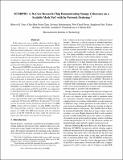| dc.contributor.author | Daya, Bhavya Kishor | |
| dc.contributor.author | Chen, Chia-Hsin | |
| dc.contributor.author | Subramanian, Suvinay | |
| dc.contributor.author | Kwon, Woo Cheol | |
| dc.contributor.author | Park, Sunghyun | |
| dc.contributor.author | Krishna, Tushar | |
| dc.contributor.author | Holt, Jim | |
| dc.contributor.author | Chandrakasan, Anantha P. | |
| dc.contributor.author | Peh, Li-Shiuan | |
| dc.date.accessioned | 2014-06-30T16:37:34Z | |
| dc.date.available | 2014-06-30T16:37:34Z | |
| dc.date.issued | 2014-06-30 | |
| dc.identifier.issn | 1063-6897 | |
| dc.identifier.uri | http://hdl.handle.net/1721.1/88132 | |
| dc.description | URL to conference program | en_US |
| dc.description.abstract | In the many-core era, scalable coherence and on-chip interconnects are crucial for shared memory processors. While snoopy coherence is common in small multicore systems, directory-based coherence is the de facto choice for scalability to many cores, as snoopy relies on ordered interconnects which do not scale. However, directory-based coherence does not scale beyond tens of cores due to excessive directory area overhead or inaccurate sharer tracking. Prior techniques supporting ordering on arbitrary unordered networks are impractical for full multicore chip designs. We present SCORPIO, an ordered mesh Network-on-Chip(NoC) architecture with a separate fixed-latency, bufferless network to achieve distributed global ordering. Message delivery is decoupled from the ordering, allowing messages to arrive in any order and at any time, and still be correctly ordered. The architecture is designed to plug-and-play with existing multicore IP and with practicality, timing, area, and power as top concerns. Full-system 36 and 64-core simulations on SPLASH-2 and PARSEC benchmarks show an average application run time reduction of 24.1% and 12.9%, in comparison to distributed directory and AMD HyperTransport coherence protocols, respectively. The SCORPIO architecture is incorporated in an 11 mm-by- 13 mm chip prototype, fabricated in IBM 45nm SOI technology, comprising 36 Freescale e200 Power Architecture TM cores with private L1 and L2 caches interfacing with the NoC via ARM AMBA, along with two Cadence on-chip DDR2 controllers. The chip prototype achieves a post synthesis operating frequency of 1 GHz (833 MHz post-layout) with an estimated power of 28.8 W (768 mW per tile), while the network consumes only 10% of tile area and 19 % of tile power. | en_US |
| dc.description.sponsorship | United States. Defense Advanced Research Projects Agency (DARPA UHPC grant at MIT (Angstrom)) | en_US |
| dc.description.sponsorship | Center for Future Architectures Research | en_US |
| dc.description.sponsorship | Microelectronics Advanced Research Corporation (MARCO) | en_US |
| dc.description.sponsorship | Semiconductor Research Corporation | en_US |
| dc.language.iso | en_US | |
| dc.publisher | Institute of Electrical and Electronics Engineers (IEEE) | en_US |
| dc.relation.isversionof | http://cag.engr.uconn.edu/isca2014/program.html | en_US |
| dc.rights | Creative Commons Attribution-Noncommercial-Share Alike | en_US |
| dc.rights.uri | http://creativecommons.org/licenses/by-nc-sa/4.0/ | en_US |
| dc.source | MIT web domain | en_US |
| dc.title | SCORPIO: A 36-Core Research Chip Demonstrating Snoopy Coherence on a Scalable Mesh NoC with In-Network Ordering | en_US |
| dc.type | Article | en_US |
| dc.identifier.citation | Daya, Bhavya K., Chia-Hsin Owen Chen, Suvinay Subramanian, Woo-Cheol Kwon, Sunghyun Park, Tushar Krishna, Jim Holt, Anantha P. Chandrakasan, and Li-Shiuan Peh. "SCORPIO: A 36-Core Research Chip Demonstrating Snoopy Coherence on a Scalable Mesh NoC with In-Network Ordering." 41st International Symposium on Computer Architecture, ISCA 2014, Minneapolis, MN, USA, June 14-18, 2014. | en_US |
| dc.contributor.department | Massachusetts Institute of Technology. Computer Science and Artificial Intelligence Laboratory | en_US |
| dc.contributor.department | Massachusetts Institute of Technology. Department of Electrical Engineering and Computer Science | en_US |
| dc.contributor.approver | Peh, Li-Shiuan | en_US |
| dc.contributor.mitauthor | Daya, Bhavya Kishor | en_US |
| dc.contributor.mitauthor | Chen, Chia-Hsin | en_US |
| dc.contributor.mitauthor | Subramanian, Suvinay | en_US |
| dc.contributor.mitauthor | Kwon, Woo Cheol | en_US |
| dc.contributor.mitauthor | Park, Sunghyun | en_US |
| dc.contributor.mitauthor | Krishna, Tushar | en_US |
| dc.contributor.mitauthor | Holt, Jim | en_US |
| dc.contributor.mitauthor | Chandrakasan, Anantha P. | en_US |
| dc.contributor.mitauthor | Peh, Li-Shiuan | en_US |
| dc.relation.journal | Proceedings of the 41st International Symposium on Computer Architecture, ISCA 2014 | en_US |
| dc.eprint.version | Author's final manuscript | en_US |
| dc.type.uri | http://purl.org/eprint/type/ConferencePaper | en_US |
| eprint.status | http://purl.org/eprint/status/NonPeerReviewed | en_US |
| dspace.orderedauthors | Daya, Bhavya K.; Chen, Chia-Hsin Owen; Subramanian, Suvinay; Kwon, Woo Cheol; Park, Sunghyun; Krishna, Tushar; Holt, Jim; Chandrakasan, Anantha P.; Peh, Li-Shiuan | en_US |
| dc.identifier.orcid | https://orcid.org/0000-0002-2345-5791 | |
| dc.identifier.orcid | https://orcid.org/0000-0001-9010-6519 | |
| dc.identifier.orcid | https://orcid.org/0000-0002-3383-1535 | |
| dc.identifier.orcid | https://orcid.org/0000-0001-7701-8303 | |
| dc.identifier.orcid | https://orcid.org/0000-0002-5977-2748 | |
| dc.identifier.orcid | https://orcid.org/0000-0003-1284-6620 | |
| dspace.mitauthor.error | true | |
| mit.license | OPEN_ACCESS_POLICY | en_US |
| mit.metadata.status | Complete | |
